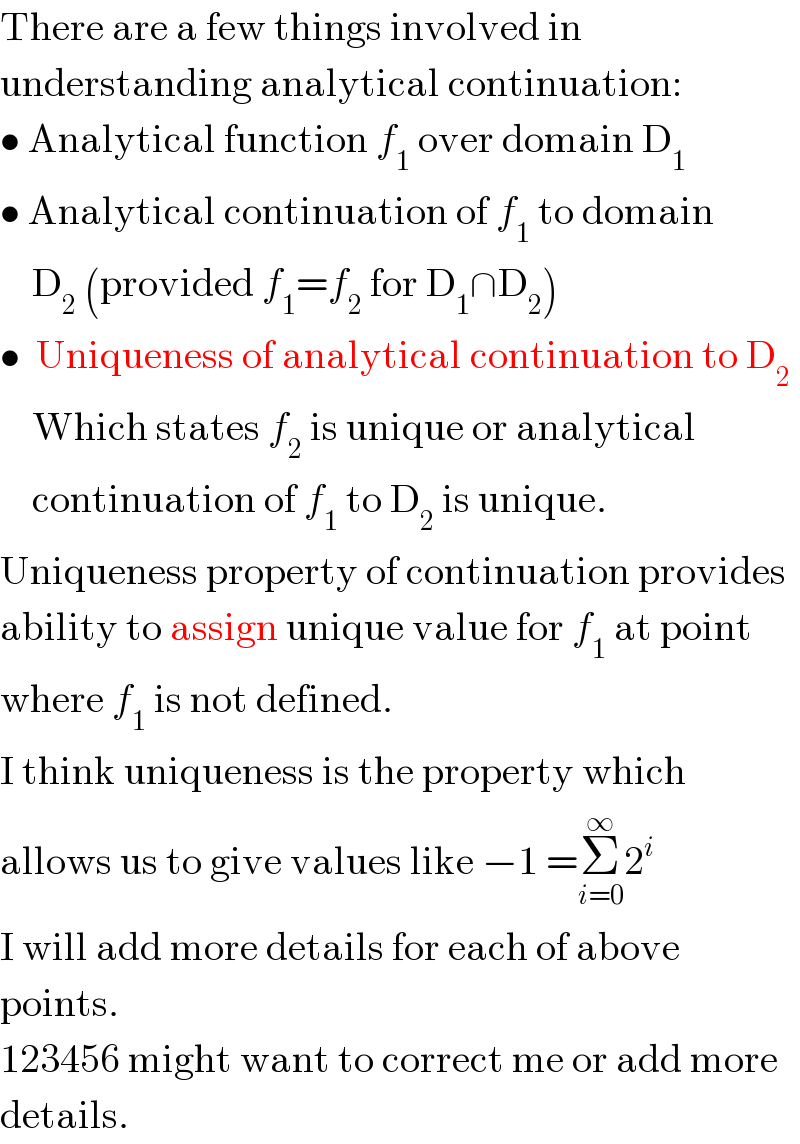
Question Number 2845 by Rasheed Soomro last updated on 28/Nov/15
![While you are in between the project I am trying to improve my digestiblity to digest the concept of ′analytical continuation′. First we make aformula to sum n terms of a powe series: ((x^n −1)/(x−1))=1+x+x^2 +...+x^n latter we change it for ∣x∣<1 and n→∞ [x^n →0] (1/(1−x))=1+x+x^2 +...+x^n and now insist to use this formula also for ∣x∣>1. WHY? [If ∣x∣ were greater than 1,then x^n ↛0 and ((x^n −1)/(x−1)) mustn′t be replaced by (1/(1−x)) ]](Q2845.png)
$$\mathcal{W}{hile}\:{you}\:{are}\:{in}\:{between}\:{the}\:{project} \\ $$$$\mathcal{I}\:{am}\:{trying}\:{to}\:{improve}\:{my}\:{digestiblity}\:{to} \\ $$$${digest}\:{the}\:{concept}\:{of}\:'{analytical}\:{continuation}'. \\ $$$$ \\ $$$${First}\:{we}\:{make}\:{aformula}\:{to}\:{sum}\:{n}\:{terms}\:{of}\:{a}\:{powe}\:{series}: \\ $$$$\frac{{x}^{{n}} −\mathrm{1}}{{x}−\mathrm{1}}=\mathrm{1}+{x}+{x}^{\mathrm{2}} +...+{x}^{{n}} \\ $$$${latter}\:{we}\:{change}\:{it}\:{for}\:\mid{x}\mid<\mathrm{1}\:{and}\:{n}\rightarrow\infty\:\left[{x}^{{n}} \rightarrow\mathrm{0}\right] \\ $$$$\:\frac{\mathrm{1}}{\mathrm{1}−{x}}=\mathrm{1}+{x}+{x}^{\mathrm{2}} +...+{x}^{{n}} \\ $$$${and}\:{now}\:{insist}\:{to}\:{use}\:{this}\:{formula}\:{also}\:{for}\:\mid{x}\mid>\mathrm{1}.\:\mathcal{WHY}? \\ $$$$\left[{If}\:\:\mid{x}\mid\:{were}\:{greater}\:{than}\:\mathrm{1},{then}\:{x}^{{n}} \nrightarrow\mathrm{0}\:{and}\:\:\frac{{x}^{{n}} −\mathrm{1}}{{x}−\mathrm{1}}\:{mustn}'{t}\right. \\ $$$$\left.{be}\:{replaced}\:{by}\:\frac{\mathrm{1}}{\mathrm{1}−{x}}\:\right] \\ $$$$ \\ $$
Answered by prakash jain last updated on 29/Nov/15

$$\mathrm{There}\:\mathrm{are}\:\mathrm{a}\:\mathrm{few}\:\mathrm{things}\:\mathrm{involved}\:\mathrm{in} \\ $$$$\mathrm{understanding}\:\mathrm{analytical}\:\mathrm{continuation}: \\ $$$$\bullet\:\mathrm{Analytical}\:\mathrm{function}\:{f}_{\mathrm{1}} \:\mathrm{over}\:\mathrm{domain}\:\mathrm{D}_{\mathrm{1}} \\ $$$$\bullet\:\mathrm{Analytical}\:\mathrm{continuation}\:\mathrm{of}\:{f}_{\mathrm{1}} \:\mathrm{to}\:\mathrm{domain} \\ $$$$\:\:\:\:\mathrm{D}_{\mathrm{2}} \:\left(\mathrm{provided}\:{f}_{\mathrm{1}} ={f}_{\mathrm{2}} \:\mathrm{for}\:\mathrm{D}_{\mathrm{1}} \cap\mathrm{D}_{\mathrm{2}} \right) \\ $$$$\bullet\:\:\mathrm{Uniqueness}\:\mathrm{of}\:\mathrm{analytical}\:\mathrm{continuation}\:\mathrm{to}\:\mathrm{D}_{\mathrm{2}} \\ $$$$\:\:\:\:\mathrm{Which}\:\mathrm{states}\:{f}_{\mathrm{2}} \:\mathrm{is}\:\mathrm{unique}\:\mathrm{or}\:\mathrm{analytical} \\ $$$$\:\:\:\:\mathrm{continuation}\:\mathrm{of}\:{f}_{\mathrm{1}} \:\mathrm{to}\:\mathrm{D}_{\mathrm{2}} \:\mathrm{is}\:\mathrm{unique}. \\ $$$$\mathrm{Uniqueness}\:\mathrm{property}\:\mathrm{of}\:\mathrm{continuation}\:\mathrm{provides} \\ $$$$\mathrm{ability}\:\mathrm{to}\:\mathrm{assign}\:\mathrm{unique}\:\mathrm{value}\:\mathrm{for}\:{f}_{\mathrm{1}} \:\mathrm{at}\:\mathrm{point} \\ $$$$\mathrm{where}\:{f}_{\mathrm{1}} \:\mathrm{is}\:\mathrm{not}\:\mathrm{defined}. \\ $$$$\mathrm{I}\:\mathrm{think}\:\mathrm{uniqueness}\:\mathrm{is}\:\mathrm{the}\:\mathrm{property}\:\mathrm{which} \\ $$$$\mathrm{allows}\:\mathrm{us}\:\mathrm{to}\:\mathrm{give}\:\mathrm{values}\:\mathrm{like}\:−\mathrm{1}\:=\underset{{i}=\mathrm{0}} {\overset{\infty} {\sum}}\mathrm{2}^{{i}} \\ $$$$\mathrm{I}\:\mathrm{will}\:\mathrm{add}\:\mathrm{more}\:\mathrm{details}\:\mathrm{for}\:\mathrm{each}\:\mathrm{of}\:\mathrm{above} \\ $$$$\mathrm{points}. \\ $$$$\mathrm{123456}\:\mathrm{might}\:\mathrm{want}\:\mathrm{to}\:\mathrm{correct}\:\mathrm{me}\:\mathrm{or}\:\mathrm{add}\:\mathrm{more} \\ $$$$\mathrm{details}. \\ $$
Commented by Rasheed Soomro last updated on 29/Nov/15

$$\mathcal{W}{hy}\:{we}\:{should}\:{be}\:{ready}\:{for}\:{changing}\:{domain}. \\ $$$${Only}\:{for}\: \\ $$$$''\mathrm{Uniqueness}\:\mathrm{property}\:\mathrm{of}\:\mathrm{continuation}\:\mathrm{provides} \\ $$$$\mathrm{ability}\:\mathrm{to}\:\mathrm{assign}\:\mathrm{unique}\:\mathrm{value}\:\mathrm{for}\:{f}_{\mathrm{1}} \:\mathrm{at}\:\mathrm{point} \\ $$$$\mathrm{where}\:{f}_{\mathrm{1}} \:\mathrm{is}\:\mathrm{not}\:\mathrm{defined}.''\:\:? \\ $$$$\mathcal{W}{hy}\:{we}\:{accept}\:{unreasonable}\:{results}\:{only}\:{for} \\ $$$${this}\:\mathrm{uniqueness}? \\ $$
Commented by 123456 last updated on 29/Nov/15

$$\mathrm{i}\:\mathrm{dont}\:\mathrm{think}\:\mathrm{this}\:\mathrm{help},\:\mathrm{but} \\ $$$$\mathrm{suppose}\:\mathrm{we}\:\mathrm{have} \\ $$$${f}:\mathbb{R}\rightarrow\mathbb{R} \\ $$$$\mathrm{and}\:\mathrm{want}\:\mathrm{to}\:\mathrm{build}\:{f}\:\mathrm{in}\:\mathrm{form}\:\mathrm{of}\:\mathrm{a}\:\mathrm{polinomy} \\ $$$$\mathrm{we}\:\mathrm{can}\:\mathrm{write}\:\left(\mathrm{under}\:\mathrm{certains}\:\mathrm{conditions}\right) \\ $$$${f}\left({x}\right)=\underset{{n}=\mathrm{0}} {\overset{+\infty} {\sum}}{a}_{{n}} \left({x}−{x}_{\mathrm{0}} \right)^{{n}} \\ $$$${a}_{{n}} =\frac{{f}^{\left({n}\right)} \left({x}_{\mathrm{0}} \right)}{{n}!} \\ $$$$\mathrm{this}\:\mathrm{serie}\:\mathrm{is}\:\mathrm{a}\:\mathrm{called}\:\mathrm{taylor}\:\mathrm{serie}\:\mathrm{of}\:{f} \\ $$$$\mathrm{near}\:\mathrm{point}\:\left({x}_{\mathrm{0}} =\mathrm{0}\right) \\ $$$$\left(\mathrm{we}\:\mathrm{can}\:\mathrm{extend}\:\mathrm{it}\:\mathrm{to}\:\mathbb{C},\:\mathrm{but}\:\mathrm{lets}\:\mathrm{stay}\right. \\ $$$$\left.\mathrm{simple}\:\mathrm{for}\:\mathrm{now}\right) \\ $$$$\mathrm{this}\:\mathrm{serie}\:\mathrm{defines}\:\mathrm{a}\:\mathrm{power}\:\mathrm{serie}\:\mathrm{to}\:\mathrm{any} \\ $$$$\mathrm{function}\:\left(\mathrm{under}\:\mathrm{certains}\:\mathrm{condictions}\right) \\ $$$$\mathrm{like} \\ $$$${f}\left({x}\right)=\mathrm{sin}\:{x}={x}−\frac{{x}^{\mathrm{3}} }{\mathrm{3}!}+\frac{{x}^{\mathrm{5}} }{\mathrm{5}!}−\centerdot\centerdot\centerdot \\ $$$$\mathrm{inside}\:\boldsymbol{\mathrm{their}}\:\boldsymbol{\mathrm{comvergence}}\:\boldsymbol{\mathrm{radius}},\:\mathrm{or}\:\mathrm{more} \\ $$$$\mathrm{direct} \\ $$$$\mid{x}−{x}_{\mathrm{0}} \mid<\mathrm{R}\Rightarrow{f}\left({x}\right)=\mathrm{sin}\:{x}={x}−\frac{{x}^{\mathrm{3}} }{\mathrm{3}!}+\centerdot\centerdot\centerdot \\ $$$$\mathrm{in}\:\mathrm{case}\:\mathrm{of}\:\mathrm{sine},\:\mathrm{this}\:\mathrm{radius}\:\mathrm{is}\:\mathrm{infinite} \\ $$$$\mathrm{however}\:\mathrm{its}\:\mathrm{not}\:\mathrm{all}\:\mathrm{function}\:\mathrm{that}\:\mathrm{have} \\ $$$$\mathrm{infinite}\:\mathrm{radius},\:\mathrm{so}\:\mathrm{in}\:\mathrm{a}\:\mathrm{gross}\:\mathrm{way}\:\mathrm{you} \\ $$$$\mathrm{can}\:\mathrm{take}\:\mathrm{the}\:\mathrm{analytic}\:\mathrm{continuations}\:\mathrm{as} \\ $$$$\mathrm{a}\:\mathrm{inverse}\:\mathrm{way}\:\mathrm{for}\:\mathrm{this}\:\mathrm{case} \\ $$
Commented by Rasheed Soomro last updated on 29/Nov/15

$$\mathcal{T}\:\boldsymbol{{h}}\:\boldsymbol{{a}}\:\boldsymbol{{n}}\:\boldsymbol{{k}}\:\mathcal{S}\:\:{to}\:\mathcal{BOTH}\:{of}\:\mathcal{YOU}\:! \\ $$
